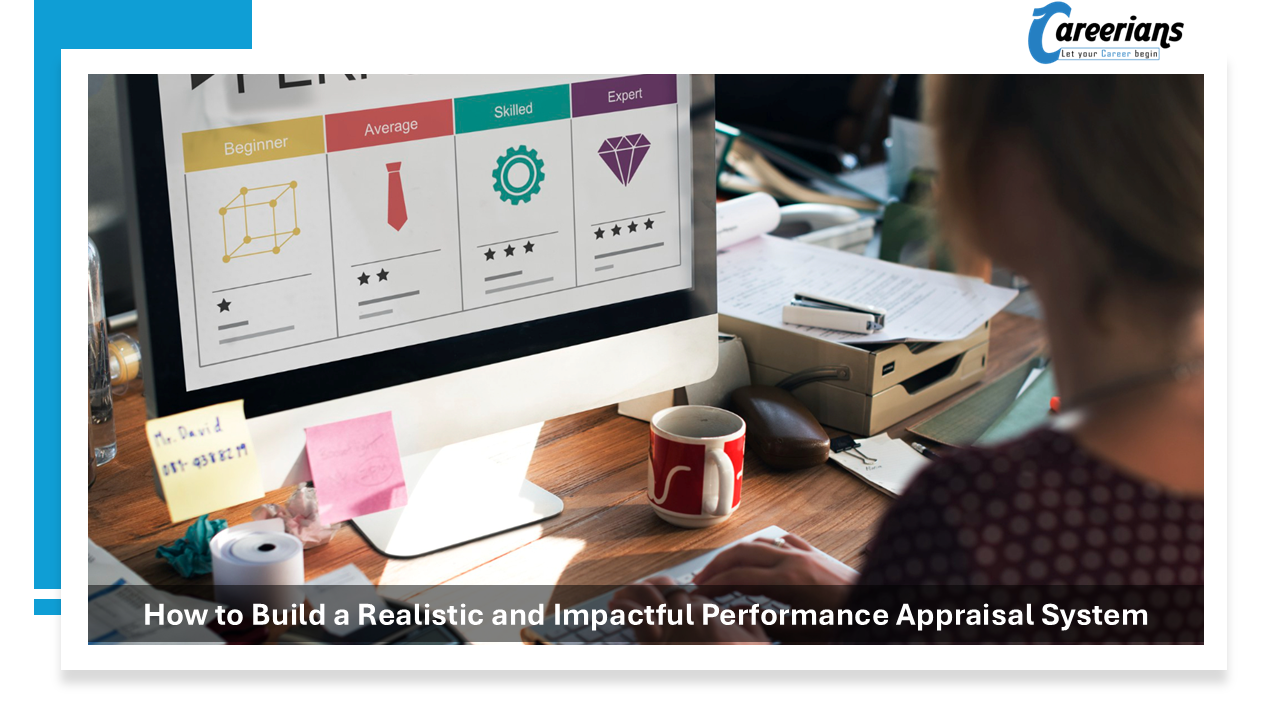
How to Build a Realistic and Impactful Performance Appraisal System
How to Build a Realistic and Impactful Performance Appraisal System
Performance appraisal is not just a yearly ritual, or a set of evaluation forms HR circulates every December.
Also, It’s not a punishment tool, nor a bureaucratic checklist.
When done right, it’s a strategic mechanism that shapes culture, enhances accountability, and drives business growth.
The truth is simple:
Two companies can have the same structure, same tools, and same budgets — yet one outperforms the other because it manages performance differently.
A well-designed performance system helps every employee understand:
-
What’s expected of them.
-
How their work contributes to company goals.
-
What they must do to grow.
But many organizations still fail to make it work.
Why? Because they treat appraisal as an administrative task, not a management tool.
This article will take you step-by-step through how to build a realistic, practical, and effective performance management system that truly transforms your organization.
🟠 1. Start With “Why” — Define the Real Purpose
Before you think about KPIs or templates, pause and ask one essential question:
Why do we evaluate performance?
If your only answer is “for bonuses,” then the system will collapse in the long run.
Performance management must serve a broader purpose — such as:
-
Improving individual and team effectiveness.
-
Supporting promotion and succession decisions.
-
Identifying training needs.
-
Strengthening accountability and communication.
Be selective.
A system that tries to do everything will end up achieving nothing.
Choose two or three main purposes and let everything else align around them.
When the purpose is clear, design decisions become easier.
🟡 2. Link Individual Goals to Corporate Strategy
Performance appraisal becomes meaningless if it’s disconnected from the company’s strategic direction.
Each employee should see a clear line of sight between their daily tasks and the organization’s broader vision.
Start with the company’s strategic objectives, translate them into departmental KPIs, and finally into individual measurable goals.
Example:
-
Company goal: Expand market share in the GCC by 15%.
-
Sales Department KPI: Increase new client acquisition by 25%.
-
Individual goal: Close at least 12 new deals per quarter.
Now every employee understands their impact, and managers can measure contribution objectively — not emotionally.
This alignment transforms appraisal from a personal judgment into a business discussion.
🟢 3. Define What to Measure — The Core Dimensions
A strong appraisal framework should measure both results and behaviors.
3.1 Job Performance (Results)
-
Quality and quantity of work.
-
Achievement of targets.
-
Timeliness and accuracy.
-
Efficiency and problem-solving.
3.2 Behavioral Competencies (How Work Is Done)
-
Communication and teamwork.
-
Initiative and adaptability.
-
Collaboration and conflict resolution.
-
Respect for company values.
3.3 Discipline and Commitment
-
Attendance and punctuality.
-
Compliance with rules.
-
Responsiveness and attitude.
A balanced weighting could look like this:
-
Job performance: 50%
-
Behavioral competencies: 30%
-
Discipline and commitment: 20%
This keeps evaluation fair — rewarding both achievement and attitude.
🟠 4. Choose Clear and Practical Rating Scales
Ambiguity kills credibility.
If “good” means something different to every manager, your data is meaningless.
Use a standardized rating scale with explicit definitions:
| Rating | Description |
|---|---|
| 5 | Consistently exceeds expectations |
| 4 | Fully meets all expectations |
| 3 | Meets most expectations |
| 2 | Below expectations; improvement needed |
| 1 | Unsatisfactory performance |
Such a model makes scoring transparent and measurable.
You can also link each level with examples or behaviors to guide evaluators.
🟡 5. Design the Appraisal Form Smartly
The form is the face of the system — make it friendly, functional, and meaningful.
A good form should:
-
Fit on one or two pages maximum.
-
Include clear instructions and rating explanations.
-
Have weighted sections (e.g., 40% results, 30% behavior, 30% discipline).
-
Provide space for comments from both sides.
-
Include signatures for accountability.
Add a self-assessment section so employees can evaluate themselves first.
This encourages reflection and opens two-way dialogue instead of one-way judgment.
🟢 6. Involve Managers in the Design Process
No HR department can design an effective performance system alone.
Department heads understand the job realities, performance metrics, and operational challenges far better.
Invite managers to workshops where they:
-
Help define evaluation criteria.
-
Suggest practical indicators.
-
Validate the clarity and relevance of forms.
Once they feel ownership, they’ll actually apply the system — not resist it.
🟠 7. Train Everyone Before Implementation
A performance system fails not because it’s poorly designed,
but because people don’t know how to use it properly.
Run short training sessions for both managers and employees explaining:
-
Why performance evaluation matters.
-
How to fill in the form objectively.
-
How to conduct feedback conversations.
-
What happens after the evaluation.
Keep it interactive.
Let participants practice real-life examples and role-plays.
Training ensures consistency, fairness, and buy-in across the organization.
🟡 8. Conduct Effective Review Meetings
The appraisal meeting is not a ceremony.
It’s the core of performance management — a coaching conversation, not a verdict.
To make it work:
-
Schedule it in advance, in a quiet, private setting.
-
Review results together; celebrate achievements before discussing gaps.
-
Encourage the employee to share their self-evaluation first.
-
Listen more than you talk.
-
Agree on 3–5 improvement actions for the next period.
End the meeting with mutual understanding — not conflict.
🟢 9. Turn Results Into Actionable Development Plans
Numbers mean nothing without follow-up.
For each employee, convert evaluation data into a Personal Development Plan (PDP) or Individual Development Plan (IDP).
That plan should highlight:
-
Strengths to leverage.
-
Weaknesses to address.
-
Relevant training programs or mentoring opportunities.
-
A follow-up timeline to track progress.
This makes appraisal part of a continuous improvement cycle — not an annual event.
🟠 10. Review and Adjust the System Regularly
Performance management is a living process.
It must evolve with business priorities, new roles, and organizational growth.
Review your system at least once a year:
-
Are the KPIs still relevant?
-
Are the weights balanced?
-
Are managers applying ratings consistently?
-
Are employees seeing value in the process?
Gather feedback and refine accordingly.
An outdated system demotivates people faster than having no system at all.
🟡 11. Link Appraisal Results to Rewards and Promotions
An appraisal with no impact is a wasted effort.
If performance ratings don’t influence pay or career progression, employees will stop caring.
Connect results to tangible outcomes:
-
90%+ = full bonus and promotion consideration.
-
75–89% = partial bonus and training plan.
-
Below 60% = improvement program or performance warning.
This integration keeps the system credible and performance-driven.
🟢 12. Ensure Fairness and Transparency
The credibility of your performance system depends entirely on trust.
Employees must believe the process is fair — otherwise, everything collapses.
To strengthen fairness:
-
Communicate all criteria openly.
-
Train managers to avoid bias.
-
Use multiple evaluators or 360° feedback for key roles.
-
Audit ratings to ensure consistency.
Fairness builds engagement.
Engagement builds loyalty.
Loyalty builds results.
🟠 13. Leverage Technology to Simplify the Process
Manual forms lead to delays, lost data, and endless spreadsheets.
Move to a digital performance management system — even a basic one.
You can start small:
-
Use Google Forms or Excel dashboards.
-
Automate average scores and reports.
-
Track trends across departments.
As the system matures, upgrade to integrated HR software.
Automation improves speed, accuracy, and analytics, giving HR the ability to visualize performance across the entire organization.
🟡 14. Integrate Appraisal Into the Organizational Culture
A performance system cannot survive if the culture resists it.
Culture eats processes for breakfast.
Make appraisal a development culture, not a “punishment season.”
Encourage leaders to discuss performance openly and frequently, not once a year.
Reward improvement, not just achievement.
When people see that feedback leads to growth, they start welcoming it instead of fearing it.
🟢 15. Shift From Annual Appraisal to Continuous Feedback
Modern organizations are moving from yearly reviews to ongoing performance conversations.
Instead of waiting 12 months to discuss results, managers conduct quick “check-ins” every quarter — sometimes every month.
Benefits:
-
Faster recognition and correction.
-
Stronger communication.
-
Continuous motivation and learning.
You can still keep the annual summary,
but build a culture where performance is a dialogue, not a document.
🟠 16. Make Managers Accountable for Managing Performance
The HR department’s role is to design and support — not to “own” performance.
The real responsibility lies with managers.
Include performance management outcomes as part of each manager’s KPIs.
Evaluate them on how effectively they coach, guide, and improve their teams.
When managers realize their own success depends on developing people,
they’ll start treating appraisal seriously.
🟡 17. Communicate the Value Continuously
Launching a system is one thing — sustaining it is another.
Use internal communication to remind everyone that performance appraisal is not about “control” but about “growth.”
Share success stories of employees who improved through feedback.
Highlight promotions that resulted from strong performance.
Recognize managers who give quality feedback.
Communication keeps the system alive in people’s minds.
🟢 18. Build a Data-Driven Performance Culture
With modern HR analytics, you can turn appraisal results into powerful insights:
-
Identify top performers and retention risks.
-
Correlate training programs with performance improvement.
-
Track diversity and fairness in ratings.
Use dashboards and data visualization to guide decision-making.
When leadership sees the numbers, they start treating performance management as a strategic business tool — not HR paperwork.
🟠 Conclusion
Performance appraisal is not a form to fill; it’s a philosophy of growth.
It aligns individuals with strategy, drives accountability, and builds a culture of transparency and development.
Start small — define the purpose, simplify the form, train your people, and communicate consistently.
Then refine, digitize, and scale.
The goal isn’t to have a “perfect” system.
The goal is to have a living process that continuously evolves with your people and your business.
When employees trust the system,
managers respect the data,
and leadership acts on results —
that’s when performance management becomes a true engine of organizational success.




